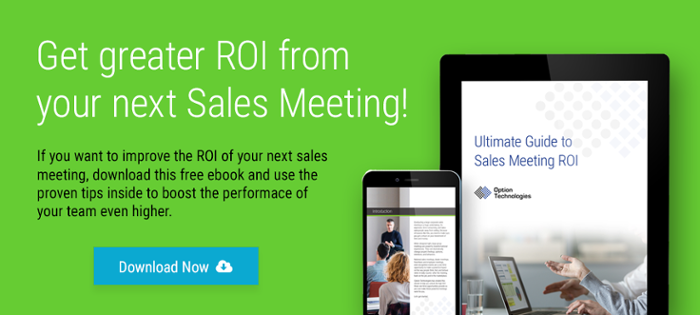“Are we getting our money’s worth?” The question comes up again and again as sales managers implement new software, training, and productivity solutions. The big bosses want to know if the investment in sales meetings is worth it.
To prove there’s value, you need to understand the three Rs of meetings management: return on investment (ROI), return on objectives (ROO), and return on experience (ROE).
ROI
Probably the most commonly understood of the three, ROI is the basic financial return on the monetary outlay. It’s the measurement that gets accountants wringing their hands and worrying about the budget - and for good reason. If the ROI is terrible, the company is throwing its money away on the program. That’s hard to defend.
But how exactly do you measure “return”? Hugh K. Lee, president of Fusion Productions, a company that does design, production and technology services for the meetings industry, often sees stakeholders demanding to know how events specifically achieve strategic business objectives. They want to see financial growth, and they want to know how costs will be reduced.
“There are multiple levels of measuring success in meetings,” Lee says. “They range from determining satisfaction and loyalty to looking more at the business process of change, and business and financial impact.”
ROO
Your ROO - return on objectives - provides a partial answer to the ROI question. Even if it’s hard to pin down the exact financial benefit, you may be experiencing a positive impact on other company objectives, like diversity, industry knowledge, customer satisfaction, or fewer mistakes.
Jack Phillips, chairman of the ROI Institute, is a leader in developing the world-wide definition of ROI and the methodology behind it. In a conversation with Meetings Today magazine, he provides a definition of ROI that includes ROO within it.
“When you use the word ‘return’ on something, your accounting department gets involved,” Phillips says. “We should just call it ‘reaction’ - as in measuring satisfaction after your meeting. That’s the first level in the ROI methodology. The second is learning. What do your attendees now know that they didn’t know before they came to your meeting? The third is application: What will they do with what they took away from your meeting? And the fourth is impact: the consequence of that application. Those four levels of objectives are part of the ROI methodology. The fifth level is where we take the impact measure and compare it to the cost of the event. Only a few events need to be taken to that level.”
ROO shows that the impact should be measured beyond financial boundaries. You may need employee surveys, electronic voting, or data tracking to determine the far-reaching effects of your meeting.
ROE
In a similar way to ROO, ROE - return on experience - reaches beyond the budget. Each meeting participant’s individual experience - and, in turn, each customer’s experience with your company - has value.
In fact, in the world of ecommerce, some company directors are calling ROE “the new ROI” because experiences are such powerful, memorable forces. When a meeting can deliver an experience that is unique and relevant to its attendees, they will be more engaged and more likely to work together on actionable outcomes.
Imagine a seminar where the entire crowd joins together to play an interactive game on provided iPads. The atmosphere is upbeat and fun, and every attendee learns an important lesson about company productivity.
What’s the value of this experience? We know there is a value, because every audience member learned something. They felt more energized after the experience. There was a sense of increased motivation and camaraderie.
Proof
If “increased motivation and camaraderie” isn’t enough tangible measurement for the higher-ups, you can prove the benefits in other ways. In the weeks and months following your seminar, look for improved measures like:
- Reduction in errors
- Lower staff turnover
- Fewer sick days
- More sales calls
- Shorter pending close sale periods
- More closed deals
- More upsells and cross-sells
In terms of proof, TIm Brown, CEO of Meeting Sites Resources, reminds meeting planners that they must think like the top strategic planners in their companies.
“Planners are so focused on logistics, it is often a stretch to move to the strategic level,” Brown says. “But they must look at meetings as investments, and regard themselves as general contractors who are accountable to both an organization’s stakeholders and meeting or event attendees. Everyone expects a certain bang for their bucks.”
To get more bang for your meeting bucks, contact Option Technologies before your next sales meeting.


